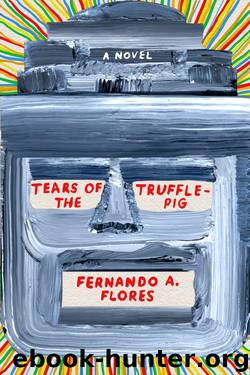Tears of the Trufflepig: A Novel by Fernando A. Flores

Author:Fernando A. Flores [Fernando A. Flores]
Language: eng
Format: epub
ISBN: 9780374720148
Publisher: MCD x FSG Originals
Published: 2019-05-14T04:00:00+00:00
TWELVE
The public classics network was airing a black-and-white Cagney picture, Frankie’s Ride. Cagney played Frankie McClint, a poor boy from the Bronx who made it big in the bootlegging racket during Prohibition. Never knowing his own father, the only real paternal figure Frankie rebelled against in his life was Father Andrews, the Irish Catholic priest. The famous scene of the picture was playing—Father Andrews is pleading with a sharply dressed, wisecracking Cagney to quit the bootlegging business and become a positive role model for the neighborhood youths.
“Don’t you see, Frankie, that these boys have grown up idolizing you? You’ve got them picking pockets and running numbers. And for what, I wonder? I wonder, Frankie, do you ever see anything of yourself in these boys anymore?”
“Firstly, Father,” Cagney responds, slyly fixing the cuff links on his suit, “if you’re accusing me of asking these boys to commit crimes then you are mistaken. I’m a businessman, not a barbarian. These boys have a right to be boys, and if they’re able to contribute a little to their families then nobody can argue that what they’re doing is entirely bad. Now, if I’m supposed to lose sleep because my success has an influence on these boys’ futures, then you are sorely out of line, Father. We all know the hero you’d like them to have is up there on the cross, and the Church ain’t putting food on the table for any of these youngsters.”
“That’s where you’re wrong, Frankie. What the Church puts on the table goes a lot farther than food.”
Bellacosa was watching and enjoying the picture. It was his second time catching it as it aired, but he had never seen it from the beginning. The depiction of poverty in those old pictures, for Bellacosa, always reminded him of his boyhood in Reinahermosa. It didn’t matter if the film was Italian, German, Swedish, Japanese. The poverty depicted, especially in the two decades of cinema around World War II, was always a visceral, universal poverty. Once he’d seen a Japanese film about a murder in the Tokyo ghetto, and he felt he knew the smell of those shantytown, underworld locations, the rubble of the buildings, the children playing in trash heaps looking for diamond rings. If the actors had been Mexican he would’ve sworn it was a picture about his own childhood.
Bellacosa didn’t care to watch Cagney die in the unfortunate climax again and turned off the black-and-white replica, put it back in the closet. He walked over to his altar, grabbed the stick of white sage by the picture of his wife holding their daughter, moments after her birth. He lit the stick and watched the white sage burn a green smoke that carried the smell of something infinite, like it was cut from the tree of life itself, and he placed it on the onyx rock. He grabbed the Bengali quartz crystal, the agave stone, midnight-rose-quartz rock, the jawbone of the Texas coyote. The stones he placed in a glass
Download
This site does not store any files on its server. We only index and link to content provided by other sites. Please contact the content providers to delete copyright contents if any and email us, we'll remove relevant links or contents immediately.
We Ride Upon Sticks by Quan Barry(34408)
The Secret History by Donna Tartt(18803)
Norse Mythology by Gaiman Neil(13167)
Crooked Kingdom: Book 2 (Six of Crows) by Bardugo Leigh(12198)
The Betrayed by Igor Ljubuncic(11762)
The Betrayed by Matthew Dickerson(11570)
Caraval Series, Book 1 by Stephanie Garber(10142)
Year One by Nora Roberts(9674)
Oathbringer by Brandon Sanderson(9465)
Twilight Siege: A Dark Fantasy Novel (The Fae Games Book 2) by Jill Ramsower(9345)
The Priory of the Orange Tree by Samantha Shannon(8854)
The City of Brass by S. A. Chakraborty(8729)
Red Rising by Pierce Brown(8563)
Confessions of an Ugly Stepsister by Gregory Maguire(7806)
Little Fires Everywhere by Celeste Ng(7084)
Shalador's Lady by Anne Bishop(6783)
This Is How You Lose Her by Junot Diaz(6758)
Storm and Silence by Robert Thier(6726)
Shadows Of The Apt [01] - Empire in Black and Gold by Adrian Tchaikovsky(6622)
